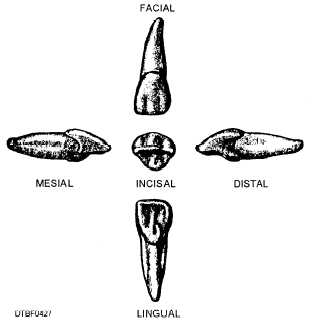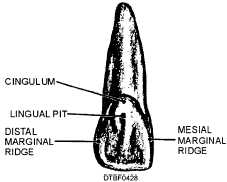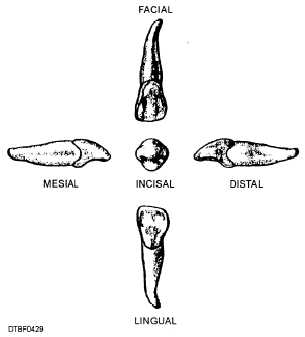
Figure 4-27. - Surfaces of a maxillary central incisor.
Lingual Surface
- The lingual surface (fig. 4-28) is quite similar to the facial surface in outline except that it is slightly smaller in all dimensions. At the mesial and distal margins there are marginal ridges. Occasionally there is a cingulum at the junction of the lingual surface with the cervical line. Sometimes a deep pit, the lingual pit, is found in conjunction with a cingulum.
Root Surface
- As with all anterior teeth, the root of the maxillary central incisor is single. This root is from one and one-fourth to one and one-half times the length of the crown. Usually, the apex of the root is inclined slightly distally.
MAXILLARY LATERAL INCISORS
The maxillary lateral incisor (tooth #7 or #IO), illustrated in figure 4-29, is much like the maxillary central incisor, except in size: it is shorter, narrower, and thinner.

Figure 4-28. - Features of a lingual surface of maxillary central incisor.

Figure 4-29. - Surfaces of a maxillary lateral incisor.
Facial Surface
- The developmental grooves on the facial surface are not so evident as those of the central incisor. Of more significance, however, is the distoincisal angle, which is well-rounded with this curvature continuing to the cervical line. The mesiofacial angle is nearly straight to the cervical line.
Lingual Surface
- The shape of the lingual surface varies with the individual. In some persons it is markedly concave, almost spoon-like in appearance, and in others, it is flat. The lingual surface is almost the same as the facial surface.
Root Surface - The root is conical (cone-shaped) but somewhat flattened mesiodistally.
MANDIBULAR CENTRAL INCISORS
The mandibular central incisor (tooth #24 or #25) is illustrated in figure 4-30. These are the first permanent teeth to erupt, replacing deciduous teeth, and are the smallest teeth in either arch.
Facial Surfaces
- The facial surface of the mandibular central incisor is widest at the incisal edge. Both the mesial and the distal surfaces join the incisal surface at almost a 90° angle. Although these two surfaces are nearly parallel at the incisal edge, they converge toward the cervical margin. The developmental grooves may or may not be present. When present, they appear as very faint furrows. 4-16
